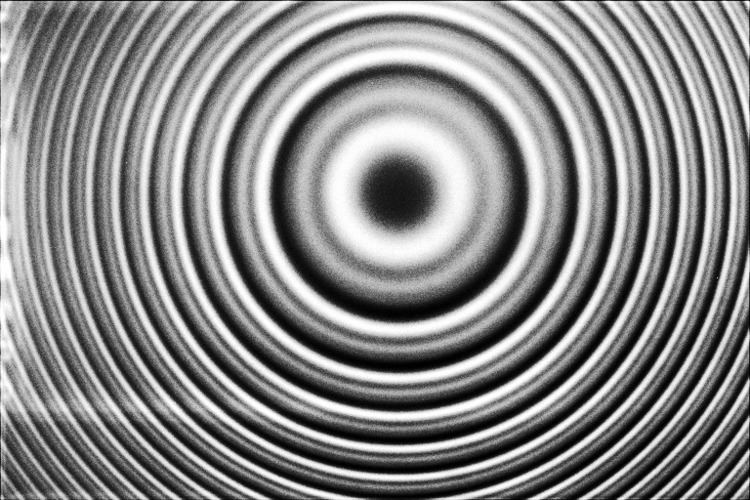 | ||
In atomic physics, the fine structure describes the splitting of the spectral lines of atoms due to electron spin and relativistic corrections to the non-relativistic Schrödinger equation.
Contents
The gross structure of line spectra is the line spectra predicted by the quantum mechanics of non-relativistic electrons with no spin. For a hydrogenic atom, the gross structure energy levels only depend on the principal quantum number n. However, a more accurate model takes into account relativistic and spin effects, which break the degeneracy of the energy levels and split the spectral lines. The scale of the fine structure splitting relative to the gross structure energies is on the order of (Zα)2, where Z is the atomic number and α is the fine-structure constant, a dimensionless number equal to approximately
The fine structure energy corrections can be obtained by using perturbation theory. To do this one adds three corrective terms to the Hamiltonian: the leading order relativistic correction to the kinetic energy, the correction due to the spin-orbit coupling, and the Darwinian term. The full Hamiltonian is given by
where
Kinetic energy relativistic correction
Classically, the kinetic energy term of the Hamiltonian is
where
However, when considering a more accurate theory of nature via. special relativity, we must use a relativistic form of the kinetic energy,
where the first term is the total relativistic energy, and the second term is the rest energy of the electron. (
Then, the first order correction to the Hamiltonian is
Using this as a perturbation, we can calculate the first order energy corrections due to relativistic effects.
where
We can use this result to further calculate the relativistic correction:
For the hydrogen atom,
where we have used:
On final calculation, the order of magnitude for the relativistic correction to the ground state is
Spin-orbit coupling
For a hydrogen-like atom with
The spin-orbit correction can be understood by shifting from the standard frame of reference (where the electron orbits the nucleus) into one where the electron is stationary and the nucleus instead orbits it. In this case the orbiting nucleus functions as an effective current loop, which in turn will generate a magnetic field. However, the electron itself has a magnetic moment due to its intrinsic angular momentum. The two magnetic vectors,
Notice that there is a factor of 2, called the Thomas precession, which comes from the relativistic calculation that changes back to the electron's frame from the nucleus frame.
Since
the expectation value for the Hamiltonian is:
Thus the order of magnitude for the spin-orbital coupling is
Remark: On the (n,l,s)=(n,0,1/2) and (n,l,s)=(n,1,-1/2) energy level, which the fine structure said their level are the same. If we take the g-factor to be 2.0031904622, then, the calculated energy level will be different by using 2 as g-factor. Only using 2 as the g-factor, we can match the energy level in the 1st order approximation of the relativistic correction. When using the higher order approximation for the relativistic term, the 2.0031904622 g-factor may agree with each other. However, if we use the g-factor as 2.0031904622, the result does not agree with the formula, which included every effect.
Darwin term
There is one last term in the non-relativistic expansion of the Dirac equation. Because it was first derived by Charles Galton Darwin it is referred to as the Darwin term, and is given by:
The Darwin term affects only the s-orbit. This is because the wave function of an electron with
The Darwin term changes the effective potential at the nucleus. It can be interpreted as a smearing out of the electrostatic interaction between the electron and nucleus due to zitterbewegung, or rapid quantum oscillations, of the electron. This can be demonstrated by a short calculation
Quantum fluctuations allow for the creation of virtual electron-positron pairs with a lifetime estimated by the uncertainty principle
Averaging over the fluctuations
gives the average potential
Approximating
To compare with the expression above, plug in the Coulomb potential:
This is only slightly different.
Another mechanism that affects only the s-state is the Lamb shift, a further, smaller correction that arises in quantum electrodynamics that should not be confused with the Darwin term. The Darwin term gives the s-state and p-state the same energy, but the Lamb shift makes the s-state higher in energy than the p-state.
Total effect
The total effect, obtained by summing the three components up, is given by the following expression:
where
The total effect can also be obtained by using the Dirac equation. In this case, the electron is treated as non-relativistic. The exact energies are given by
This expression, which contains all higher order terms that were left out in the other calculations, expands to first order to give the energy corrections derived from perturbation theory. However, this equation does not contain the hyperfine structure corrections, which are due to interactions with the nuclear spin. Other corrections from quantum field theory such as the Lamb shift and the anomalous magnetic dipole moment of the electron are not included.
